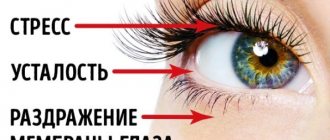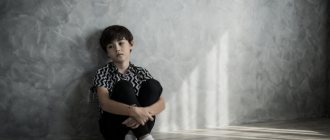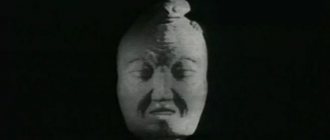These include:
- Myopia (nearsightedness).
- Hypermetropia (farsightedness).
- Astigmatism.
Ametropia may be due to the structure of the eye. In this case, this condition is permanent (often congenital), the eye requires correction (glasses/lenses).
However, there are acquired conditions that are reversible. But if there is no proper treatment or correction, this condition can turn from transient to permanent, or lead to an increase in already existing ametropia.
Myopia (nearsightedness)
With myopia, the eye is enlarged in the anteroposterior segment (longer) and, as a stronger, “convex” lens, refracts the light entering the eye more strongly. This causes the focal length to be projected in front of the retina when looking into the distance.
Diverging (minus) lenses help to “pull” the focus back onto the retina and restore clear vision. Since myopia is a permanent condition (remember that this is a feature of the structure of the eye), glasses / soft contact lenses are constantly prescribed. At the age of up to 40 years, they are prescribed for constant wear (for near, distant). After 40 years, these glasses are only worn when looking into the distance, because presbyopia comes into force - an age-related decrease in distance vision, but more on that a little later.
Laser vision correction (LASIK technique) helps to achieve the effect of constantly wearing glasses/lenses, i.e. it allows you to see well without the use of optical correction.
Astigmatism
It is a structural feature of the cornea that leads to vision distortion and/or double vision. It can be present either isolated in the eye or accompany myopia or myopia. For the purpose of correction, glasses with a cylindrical component in the lens or soft contact lenses (SCL) are prescribed. Externally, these glasses are no different from ordinary ones. Performing LASIK can correct the structure of the cornea, and the patient will forget about astigmatism.
It is important to understand that properly selected glasses do not worsen your vision! It is a myth.
Over the past decade, devices designed to simplify our lives and communications have become firmly established in our everyday life. Wearable electronics come in a variety of shapes, sizes and purposes. People have been using a personal computer for even longer. And it’s hard to calculate how long a person has been using printed publications.
An increase in tasks that require long-term visual load, as well as the emergence of new professions where the main activity is performed at the computer, leads to an increase in disorders associated with increased visual load.
These conditions can be acute, subacute, become chronic, or lead to changes in the structure of the eye:
- Presbyopia.
- Spasm of accommodation.
- PINA (habitual excess tension of accommodation).
- Paresis and paralysis of accommodation.
- Accommodative asthenopia.
Symptoms of the disease
A subjective manifestation of a spasm of accommodation can be a deterioration in distance vision. In addition, the symptoms of this disease are: rapid visual fatigue when working close, a burning sensation, stinging and pain in the eyes, double vision, pain in the forehead and temples. Eye redness and watery eyes are often observed. Often children present vague complaints of fatigue and headache; become irritable, school performance declines, which is often incorrectly interpreted by adults as hormonal changes in the body, according to age. The duration of the spasm of accommodation varies from several months to several years, often turning into persistent myopia.
Depending on the form and type of accommodation disturbances, and on the level of visual stress, other symptoms may be observed, such as nausea, vomiting, and problems maintaining balance.
Pathological spasm of accommodation is characterized by both ocular symptoms (anisocoria, nystagmus, eyelid tremor) and general manifestations. Patients often experience vegetative-vascular dystonia, decreased mood, emotional lability, hyperhidrosis of the palms, migraine attacks, and trembling fingers.
Presbyopia
When the ciliary muscle is tense, the ligaments of Zinn, to which the lens capsule is attached, relax. As a result, the lens becomes more convex, slightly lowered, and the pupil narrows, providing clearer near vision. As the lens becomes more convex, it gains additional optical power, thereby bringing the focal length closer to the eye. However, after 40-45 years, the lens loses its elasticity and cannot fully take on a convex shape. The ciliary muscle also loses its strength with age, and presbyopia gradually increases.
This condition is not a pathology, but a physiological norm. It cannot be excluded, but it can be delayed for several years.
The onset of presbyopia is accelerated due to:
- long absence of rest,
- stressful situations,
- chronic lack of sleep,
- deficiency of vitamins A, B, C,
- abnormal visual loads.
When presbyopia has already set in, the most correct decision would be to select glasses for correction. These glasses are prescribed only for close work (reading, writing or working on a PC).
Everyone is susceptible to presbyopia: nearsighted, farsighted and emmetropic (lack of ametropia). But it manifests itself in different ways.
- Emmetropia
. In this case, presbyopia proceeds in the usual way with manifestation at 40-45 years and the prescription of weak positive glasses. - Farsightedness.
Since in this case the patient already needs plus glasses for distance, the optical power of the glasses for near is added to the power of the glasses for distance. The need for glasses for near vision may appear as early as 35 years of age. - Myopia.
Patients use minus distance glasses. But we remember that the correction for near is added to the necessary correction for distance. Therefore: either the patient needs weaker minus glasses, or (with weak myopia) presbyopic glasses will be needed much later than usual.
Forms of accommodation disturbance
- asthenopia;
- spasm of accommodation;
- paralysis of accommodation;
- age-related weakening of accommodation (presbyopia).
Accommodative asthenopia Most often develops in people with farsightedness, astigmatism in the absence or incorrectly selected spectacle correction. Such patients complain of rapid eye fatigue when reading, blurred book text, redness of the eyes and edges of the eyelids, a feeling of burning, itching, foreign body (the so-called chronic blepharoconjunctivitis), headache, sometimes accompanied by vomiting. The main cause of this condition is excessive tension of accommodation nearby, while its reserves are limited. Treatment for this condition is optimal spectacle or contact correction of refractive errors.
Accommodation spasm Most often occurs in children and young people. This is a disruption of the functioning of the eye (ciliary) muscle and, as a consequence, the loss of the ability to clearly distinguish objects both near and far. In ophthalmology, a spasm of accommodation is understood as an excessively persistent tension of accommodation, caused by a contraction of the ciliary muscle that does not disappear under the influence of conditions when accommodation is not required. According to some reports, every sixth schoolchild suffers from a similar disorder.
Paralysis and paresis of accommodation As a rule, they are of a neurogenic nature or can occur as a result of injury or poisoning. In people with normal visual acuity and farsighted people, near vision deteriorates. In myopic people, visual acuity does not drop so sharply, and sometimes does not change at all. With paralysis, the volume of accommodation is reduced and its reserves are lost.
Age-related weakening of accommodation (presbyopia) is a physiological phenomenon that is associated with the age-related evolution of the lens, its compaction and gradual loss of elastic properties. Treatment - selection of optimal correction for near in accordance with age and initial refraction.
Spasm of accommodation
An acute condition in which distance vision is significantly reduced. In this condition, the ciliary muscle is sharply spasmed, the eye acquires a pronounced myopic refraction, but with maximum correction it is not possible to bring the eye to vision 1.0 (100%).
It most often occurs at the age of 12-18 years, appears abruptly, perhaps due to stress, the patient begins to see nearby objects (eyelashes, for example). There may also be pain in the area of the brow ridge.
Causes: stress, poisoning with organophosphorus compounds, use of cholinomimetics (pilocarpine hydrochloride).
In the treatment of accommodation spasm, drugs that relax the ciliary muscle are used. For persistent conditions, drugs are prescribed for a longer period. In some cases, treatment by a psychotherapist is necessary.
Habitually excessive tension of accommodation (PINA)
This is a chronic overstrain of the ciliary muscle, leading to the appearance of myopic refraction (false myopia - pseudomyopia).
The following features are noteworthy:
- school age, adolescence,
- complaints of decreased distance vision,
- develops gradually
- the appearance is associated with an increase / intensification of visual load.
Many clinical and experimental studies have proven the connection between accommodation disorders and childhood myopia, as well as the progression of myopia. PINA is inextricably linked with myopia, so it makes sense to remember what factors influence the appearance and progression of myopia.
The chain is built as follows: heredity, trauma to the cervical spine, unfavorable environmental conditions, excessive visual load -> pseudomyopia, PINA -> true myopia, PINA -> progression of myopia -> complications of myopia.
PINA is most often caused by prolonged, abnormal visual load at the wrong distance.
Myopia appears (but this is false myopia), which completely corrects vision to 1.0 (100%)
The mistake in this case would be to immediately prescribe glasses. After a course of treatment with drugs that relax the ciliary muscle, and a visual load determined by the doctor, glasses may not be needed. There are cases when, after a course of treatment, false myopia turns into farsightedness.
The sooner a child starts using tablet computers and similar electronic devices, the sooner and more likely he will develop PINA, which turns into myopia.
Reasons for development
Spasm of accommodation, as a rule, occurs in children or fairly young people, which is due to age-related characteristics of the function of the accommodative apparatus. The main causes of accommodation spasm in school-age children are high visual loads caused by prolonged viewing of TV, working with a computer, classroom furniture that is inappropriate for the student’s height, violation of the optimal reading distance, insufficient lighting, exposure to too much bright light on the eyes, etc. Development of spasm accommodation can be facilitated by an irrational daily routine, in which little time is devoted to sleep, walks in the air, exercise for the eyes and physical activity.
Among all the factors, the following are of particular importance: hypovitaminosis, asthenia, vertebrobasilar insufficiency, spinal curvature, juvenile osteochondrosis.
The list of reasons for spasm of accommodation in children also includes doing homework in the evening or at night. In this case, two factors play a role: natural fatigue of the visual organs, which occurs towards the end of the day, and increased stress on the eyes under artificial lighting.
The causes of spasm of accommodation in adults are the same as in children: excessive visual stress, unhealthy diet, violations of work and rest schedules, physical inactivity and vitamin deficiencies. In addition, along with age, other health disorders often come that directly or indirectly affect the accommodative apparatus: diseases of the spine (in particular, the cervical spine), vascular disorders, etc.
Over the course of life, the lens gradually loses its properties, and by about 45 years of age, it becomes less elastic and thickens. Such changes are associated with a decrease in the ability to see well near, that is, an age-related weakening of accommodation, called presbyopia (age-related farsightedness). Therefore, in adulthood, a spasm of accommodation occurs rarely and, as a rule, is secondary to causes such as hysteria, neurosis, traumatic brain injury, menopause, etc. The occurrence of a spasm of accommodation is often facilitated by activities that are associated with small work at close range (watchmakers , jewelers, embroiderers, etc.).
Weakness of accommodation
A condition in which accommodation is difficult (near vision). This is a long-term condition that is often accompanied by PINA. If accommodation is weak, the ciliary muscle cannot remain in a tense state for a long time; it weakens.
Patients complain of fatigue and fatigue when reading and writing. The closest point of clear vision approaches the eye. In this case, the ciliary muscle must be stimulated. The drug of choice is Irifrin 2.5%. Weakness of accommodation can also lead to the appearance or intensification of existing myopia.
Accommodation indicators
The eye's ability to accommodate can be measured. This allows you to evaluate:
- area of accommodation. At its core, this parameter determines in what range a person maintains clarity of vision. To do this, the farthest and closest points are measured, between which the accommodation area is located - the interval in which the normal quality of vision is maintained.
- volume of accommodation. This indicator measures the difference in refraction between two points - the closest and the farthest - within which clarity of vision is maintained.
- Accommodation reserve. When measuring this parameter, the fixation point is used - the area on which the patient keeps his gaze. The volume of accommodation that is not used when installed at the fixation point determines its reserve or reserve.
Paralysis and paresis of accommodation
This is an acute or subacute condition in which the eye loses the ability to see an object located at close range.
There are disorders of the central
or
peripheral
origin.
Peripheral genesis is a consequence of the use of m-anticholinergics (Atropine).
Central - may be a consequence of an acute illness: intoxication, influenza, scarlet fever, diphtheria, poisoning with carbon disulfide, lead, injury or tumor of the central nervous system, severe stress. Well corrected with plus glasses.
In this case, it is possible to assign:
- temporary plus points,
- the drug pilocarpine,
- acupuncture, laser stimulation of the ciliary muscle.
Accommodative asthenopia
This is a symptom complex that includes discomfort, fatigue during prolonged work, and decreased vision at distance and near. Patients report pain.
During the examination, there may be slight refractive errors (myopia, hypermetropia), which are either not corrected at all or incorrectly corrected.
It is necessary to use adequate optical correction, stimulate the ciliary muscle, and use adrenergic agonists.
If you feel that your vision has deteriorated - this is interfering with work, reading, etc., you should consult an ophthalmologist to determine the cause. The doctor can make the right decision based on the examination and examination: what measures to take, whether to prescribe treatment or choose glasses for temporary or permanent wear.






